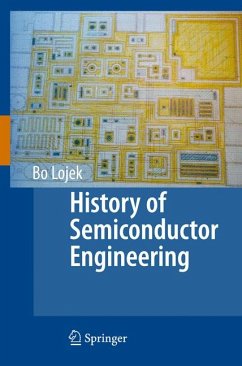"Your book is going to make a major contribution to semiconductor history. You and I agree that, while the world loves a hero, semiconductor progress depended on the efforts and ideas of a large number of people, and that moving forward depended on contributors going back a few decades in some cases. Also, as is the case with most inventions, a number of people with access to the same pool of common knowledge were working independently at the same time to put it all together and to make the necessary extensions to the existing technology and who realized that the time was right for society to accept the new concepts. Your diligent research points all of this out."
Dr. Jay Last, Former Shockley Laboratories employee, co-founder of Fairchild Semiconductor, co-founder of Amelco Semiconductor, and manager of Fairchild'sgroup which designed and produced the world first planar integrated circuit.
"Bo Lojek presents a remarkable document of the most important and significant technical development of our times. He describes in astounding detail the engineering efforts of modern microelectronics. He concentrates on the history of silicon semiconductor devices. California's "Silicon Valley" is the center of attention, together with its ancestry of transistor invention at Bell Laboratories. He has collected a wealth of illustrative documentation, gives incisive insight into the lives of the main actors and shows the often tragic fates of the engineers and businessmen. He does not hide his firm belief in the individual engineer and warns of the retarding influence of present-day political correctness."
Dr. Hans J. Queisser, Former Shockley Semiconductor scientist and retired director of the Max-Planck-Institute for Solids, Stuttgart, Germany.
"The technical history of the semiconductor history rivals the 1849 California Gold Rush as a period filled with excitement and opportunity. Although I cannot first hand validate its complete accuracy, I enthusiastically encourage you to read the collected facts, opinions, and views of an author who was actually part of this amazing period, viewing it as a successful practicing Engineer during this "gold rush" - like hey-day of the semiconductor industry.
For educators and technologists you will find this collection of data, facts, and opinions, collected and observed first hand by the author, fascinating! It is a tough read for others due to the writing experience of the author and its technical focus."
John F. Gifford, Former Fairchild Semiconductor Marketing Manager of Linear Integrated Circuits, co-founder of Advanced Micro Devices, and President and Chief Executive Officer of Maxim Integrated Products.
"Bo Lojek gets it right! There are few industries as dynamic as semiconductors and thehistory of the semiconductor industry is still unfolding. This book gives the history of people, places and technology that resulted in today's semiconductor industry. I particularly like the inclusion of many technical pieces in the book."
Robert Dobkin, Former National Semiconductor Director of Advanced Circuit Development and co-founder and Chief Technical Officer of Linear Technology Corporation.
Dieser Download kann aus rechtlichen Gründen nur mit Rechnungsadresse in A, B, BG, CY, CZ, D, DK, EW, E, FIN, F, GR, HR, H, IRL, I, LT, L, LR, M, NL, PL, P, R, S, SLO, SK ausgeliefert werden.









